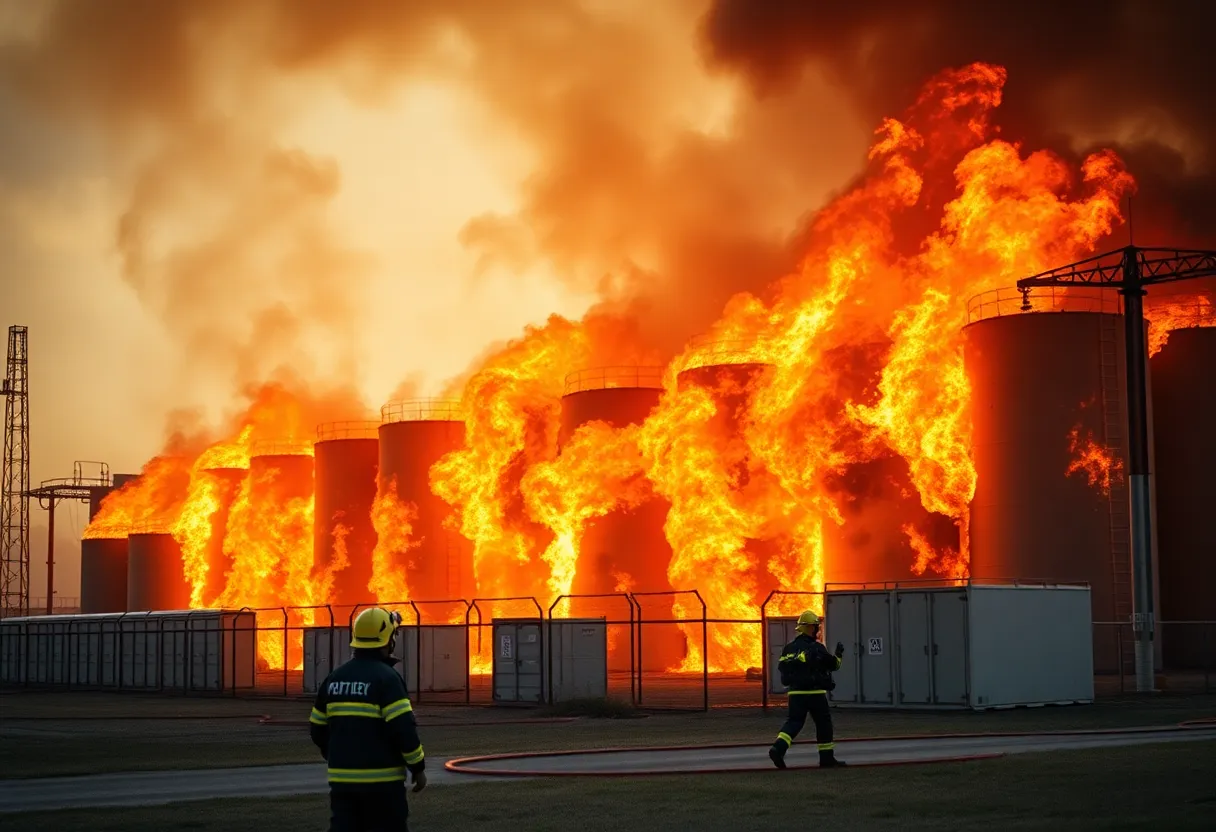

Firefighters responding to the major fire at Vistra Energy's Moss Landing battery storage facility.
A significant fire broke out on January 16, 2025, at Vistra Energy’s Moss Landing battery storage facility in California, leading to evacuations and safety concerns. The blaze, which targeted lithium batteries, compromised energy capacity and raised alarms about public health due to possible toxic emissions. Despite previous incidents, the situation highlighted the crucial need for enhanced safety protocols within the renewable energy sector as California faces challenges in maintaining its clean energy goals.
A fire that erupted at Vistra Energy’s world’s largest battery storage plant is sending shockwaves through the energy industry and local communities. The incident occurred on January 16, 2025, in Monterey County, California, and it has left a substantial mark on both the area’s safety protocols and its energy storage capabilities.
The fire broke out around 3 PM on January 16, quickly engulfing a concrete building housing stacks of lithium batteries. This facility packs a serious punch with a capacity of 750 megawatts and 3,000 megawatt-hours of energy storage. However, with this fire taking out about 300 megawatts of energy capacity—equating to about 2% of California’s total energy storage—local energy stability is now at stake.
The blaze had serious implications for the surrounding communities, resulting in the evacuation of between 1,200 and 1,700 residents from areas near Moss Landing and Elkhorn Slough. Concerns about toxic smoke plumes filled the air—potentially carrying harmful heavy metals and PFAS, known as “forever chemicals,” that impact both human and wildlife health.
While local air monitoring showed no immediate signs of toxic hydrogen fluoride gas detected during the fire, officials had their fingers crossed that risks were minimized. The fire suppression system that was supposed to extinguish the flames faltered, prompting firefighters to make the tough decision to allow the lithium fire to burn itself out. They faced challenges due to the high temperatures and the toxic emissions typically associated with lithium-ion battery fires.
By the morning of January 17, firefighters reported minimal flames and smoke, providing a glimmer of hope. Yet, the fire flared back to life later that afternoon, extending evacuation orders once again. Local officials advised residents to stay indoors with their windows and doors shut.
While the situation remained tense, it’s worth noting that there were no reports of injuries tied to this troubling event. However, it provided a striking reminder that the batteries fueling California’s clean energy goals come with significant safety considerations.
Monterey County’s Supervisor referred to the incident as a “wake-up call” for the renewable energy sector regarding battery safety. This is particularly striking given that Vistra Energy had faced prior challenges, including battery malfunctions and overheating incidents at the same facility in 2021 and 2022. With these safety concerns now firmly in the spotlight, there may be a pressing need for a reevaluation of safety protocols throughout the lithium battery storage industry.
The facility’s setback complicates California’s ambitious clean energy targets. As the state relies heavily on large-scale battery systems to stabilize its electrical grid, the loss of energy storage capacity at Moss Landing poses a significant challenge. It may take years to reconstruct the facility and restore its battery capacity, and that could deeply affect efforts to decarbonize the state’s energy sector.
Despite this incident, the California Energy Storage Association reported a 97% drop in failures for utility-scale battery systems globally from 2018 to 2023, illustrating that while challenges remain, advancements in safety and technology are possible.
In the wake of the fire, all schools within the North Monterey County Unified School District closed, prioritizing the safety of students and staff. After several air quality tests from the EPA, officials detected no immediate threats, helping to clear the way for lifting evacuation orders by the evening of January 17.
Ultimately, this latest fire marks the fourth incident at the Moss Landing facility since 2019, raising pressing questions about the overall safety of lithium-ion batteries in California. As this wild situation unfolds, communities and officials alike hope for swift measures to ensure safety, restore capacity, and bolster public confidence in the renewable energy sector.
News Summary A new AI-powered paywall has been launched, showing a 6% rise in average…
News Summary The California Bar Exam has faced scrutiny after it was revealed that many…
News Summary President Trump’s recent announcement of a 145% tariff on Chinese goods has sparked…
News Summary New Jersey is battling a large wildfire called the Jones Road Wildfire, which…
News Summary A coalition of twelve U.S. states, led by New York, is taking legal…
News Summary North Carolina introduces the Prevent Environmental Hazards Act, a bipartisan effort to address…